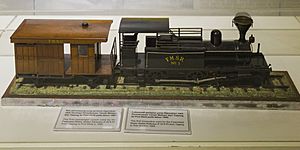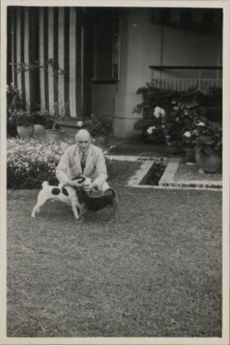Federated Malay States Railways facts for kids
| Overview | |
|---|---|
| Headquarters | Kuala Lumpur, Federated Malay States (now Malaysia) |
| Locale | British Malaya (including Singapore) |
| Dates of operation | 1901–1948 |
| Predecessor | Various state-level railways, including Perak Railway, Selangor Railway, Singapore Railway, Malacca Railway, Sungai Ujong Railway, Johore Railway, and other minor lines in British Malaya |
| Successor | Malayan Railways |
| Technical | |
| Track gauge | Metre gauge (1,000 mm (3 ft 3 3⁄8 in)) |
The Federated Malay States Railways (FMSR) was a big railway company in British Malaya (which is now Peninsular Malaysia and Singapore). It operated during the first half of the 20th century.
FMSR was created in 1901, five years after the Federated Malay States were formed. It took over many smaller railway lines that had been built separately. FMSR then expanded and connected the railway network across the Federated Malay States, the Unfederated Malay States (except Terengganu), and the Straits Settlements. Its lines stretched from Singapore in the south all the way to Padang Besar in the north, near the border with Thailand.
Contents
History of the Railways
Early Railways
Before FMSR was formed, the railway systems in Malaya were not connected. They were mostly on the west coast and built for specific reasons. For example, some were for transporting tin from mines. By the late 1800s, there were at least six different railway companies.
These included the Perak Government Railway which served tin mines, and the Selangor Government Railway that moved goods between Klang and Kuala Lumpur. There was also the Muar State Railway for farm goods and passengers in Muar, and the Sungei Ujong Railway connecting Seremban to Port Dickson.
How FMSR Started
In 1896, the Federated Malay States were created. This helped to better plan development across the region. Frank Swettenham, a key British official, suggested a big plan to connect all the railway networks.
His idea had three main parts. First, build a "development" line north to connect railways in Perak, Selangor, and Province Wellesley. This line would go through valuable but undeveloped land. Second, extend the line to Kuala Lipis, which was then the capital of Pahang, to help the mining industry there. Third, extend the Selangor Railway south to Seremban, connecting it to the Sungei Ujong Railway. This would create a direct route from Prai in the north to Port Dickson in the south.
The British government approved Swettenham's plan. They believed better transport would help farming, create more income, and make administration easier. The plan also included connecting to the Straits Settlements like Malacca and Singapore.
Construction began in 1897 and finished in 1903. The FMSR was officially founded in 1901. It first combined the Perak Railway and Selangor Railway. Over the next few years, other railway companies also joined FMSR.
Expanding the Network
Even after the main line was completed in 1903, FMSR needed to connect to Malacca and Singapore. This led to the creation of two temporary railway companies.
The Malacca Government Railway (MGR) built a line between Tampin and Malacca Town. Once finished, MGR became part of FMSR in 1905. In 1904, the Johore state government also agreed to connect its railways.
World War II and the End of FMSR
When World War II started, the Japanese Empire invaded Malaya and Singapore in 1941 and 1942. The entire FMSR network came under Japanese control. The railways didn't get much damage at first. However, during the occupation, some smaller railway lines were taken apart. Their materials were used to build the Thailand-Burma Railway. Some FMSR trains were also sent to the Thailand-Burma Railway, but they were returned after the war.
After the war ended, FMSR continued to operate for three more years. In 1948, it was renamed the Malayan Railway Administration. This company later became known as Keretapi Tanah Melayu in 1962, which is still the main railway operator in Malaysia today.
How the Railways Were Built
Railway Tracks and Signals
Years before FMSR was formed, it was decided that all new railway lines would use the same metre gauge (1000mm wide). This was so they could eventually be connected. FMSR continued to build all its lines using this same gauge. Most of the FMSR network had single tracks. There were passing loops at or near stations to allow trains to pass each other. In bigger cities, where there was more train traffic, there were double tracks.
The railway signals were mechanical and operated by hand. They used semaphore signals, which are like arms that move up and down to tell trains what to do. Stations with many tracks had a lever frame to control these signals. Sometimes, special signal boxes were built for this.
In its early days, the railway was also important for communication. Besides carrying mail, telephone wires often ran alongside the railway lines. These wires connected railway stations and nearby post offices, allowing people to send messages.
Bridges and Tunnels
Most crossings along the FMSR lines were bridges. Shorter crossings used beam bridges, while longer ones used truss bridges. These bridges were made of cast iron and steel, resting on brick supports. While much of the track was laid in cuttings (where land was dug out), several tunnels were also built. These tunnels were near places like Seremban, Bukit Berapit, and Dabong.
Sometimes, roads would go over or under the railway using road viaducts. These were often brick arch or truss bridges in busy areas. In other places, simple level crossings were used, where roads crossed the tracks directly.
Railway Buildings
Stations
FMSR railway stations came in two main types.
Most stations were simple wooden buildings. Their size depended on the town they served. Larger wooden stations had longer platforms and bigger buildings for communications, signals, luggage, and managing the station. Smaller stops might just have a small wooden shelter. Even though they were simple, many had traditional wooden carvings and cast-iron decorations. Bigger wooden stations often had homes for railway workers nearby.
The other type of station was found in larger towns and cities. These started as wooden stations but became bigger and grander as more people used them. They were built with stronger materials and had different architectural styles. Famous examples include the Kuala Lumpur station (1911) with its Indo-Saracenic Revival style, the Ipoh station (1917) in Edwardian Baroque style, and the Johore Baharu station (1932) and Tanjong Pagar station in Singapore (1932) in Art Deco style.
Some older stations, like Seremban, were also grander. They had more complex layouts, stone construction, and more platforms.
The FMSR also had a "station" in George Town, Penang (built 1907). This building managed railway operations in the north but didn't have a direct railway connection. Passengers had to take a ferry across the Penang Strait to catch a train.
Workshops and Freight
When FMSR was formed, it took over many old workshops and depots from the state railways. These were later used as smaller depots. Larger, central workshops were built for important maintenance. The biggest was the Central Workshops in Sentol, near Kuala Lumpur. Built in 1905, it was a huge place with about 5,000 employees. They built train cars, made railway parts, and fixed trains. Other major depots were in Prai and Gemas.
Since FMSR was vital for shipping goods, some stations near seaports and industrial areas also served as goods stations. They handled shipments of tin, rubber, and other important items. These stations usually had warehouses and marshalling yards for sorting goods.
Headquarters of FMSR
Throughout its history, FMSR's main office was in Kuala Lumpur. It moved a few times to different buildings. The first headquarters was a simple building from 1896. It was replaced by a more decorative, Neo-Mughal style building by 1905. This second building was also used for a short time. In 1917, FMSR moved to an even larger, dedicated Railway Administration Building on Victoria Road. This building was also in the Neo-Mughal style and faced the new Kuala Lumpur railway station. Both the second and third headquarters were designed by Arthur Benison Hubback.
The second and third FMSR headquarters buildings are still standing today. The second one is now the National Textile Museum. The third one still houses the railway operators in Malaysia, including the Malayan Railway Administration and Keretapi Tanah Melayu.
Types of Locomotives
Steam Locomotives
When FMSR first started, it got many of its trains from the railway companies it took over. From 1907 onwards, FMSR began ordering its own new locomotives. Almost all the trains used by FMSR were steam locomotives, built by companies in the United Kingdom. Most of these trains were painted all black. The Johore Railway, however, used a blue color for its trains.
FMSR Class A

The FMSR Class A was one of the first types of trains used by FMSR. These were 18 tank locomotives that had been bought by different state railways before FMSR was formed. They were the main trains for FMSR in its early years.
Some of these Class A trains were changed to run on oil instead of wood to save money. The Class A trains were slowly retired starting in the 1920s as newer trains arrived. The very last Class A train was removed from service in 1933.
Later, in 1941, FMSR got three new locomotives and also called them "new" FMSR Class A. These were used only for a short time and were sold in 1946.
FMSR Class B
The FMSR Class B locomotives were heavier and more powerful than the Class A trains. They also came from local state railways. There were only seven of these trains. Like the Class A, Class B trains were retired as new locomotives were delivered. The last Class B train was removed in 1932.
FMSR Class L
The FMSR Class L was a powerful type of locomotive introduced in 1921. There were 20 of these trains. They were ordered to avoid needing two trains to pull long passenger coaches. The Class L trains were improved versions of an earlier type, designed to pull longer coaches with less effort.
During the Japanese occupation in World War II, five Class L trains were taken to the Thailand-Burma Railway. After the war, all five were returned. These trains continued to serve FMSR and later the Malayan Railways until the 1970s. The very first Class L train, FMSR 214, was given to the National Museum in Kuala Lumpur in 1971. You can still see it there today as an outdoor exhibit.
FMSR Class WD
After World War II, FMSR bought 28 "MacArthur" locomotives from the United States Army. These were powerful 2-8-2 type trains. Some of them were later sold to the East African Railways.
See also
- Rail transport in Malaysia
- Keretapi Tanah Melayu (Malayan Railways)
- Prasarana Malaysia
- Mass Rapid Transit Corporation (Malaysia)
- Express Rail Link Sdn Bhd



